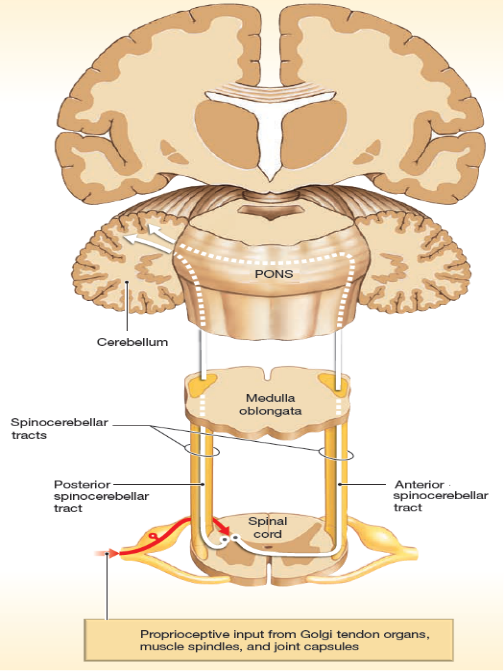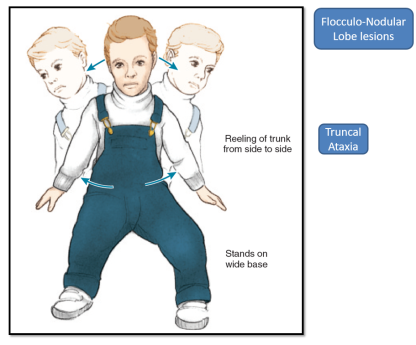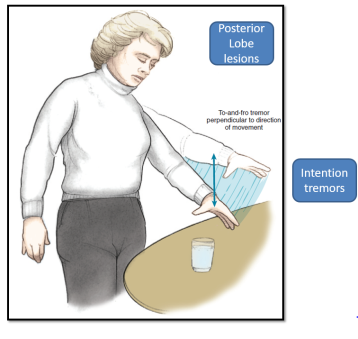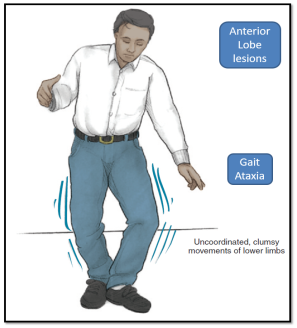Cerebellum (Cerebellar Pathway, Cells In Cerebellar Cortex) - PrepLadder
Feb 21, 2023
Navigate Quickly
CEREBELLAR ATAXIA
CEREBELLUM
CEREBELLAR PATHWAY
MOSSY FIBRES
Cerebellum Lesions Causes Ipsilateral Manifestations
CEREBELLAR CORTEX – LAYERS
DEEP CEREBELLAR NUCLEI [DEFG]
Revision
Lesions
Cells in Cerebellar Cortex
CEREBELLAR AFFERENT PATHWAYS
CEREBELLAR PATHWAYS
INCOMING FIBRES & CEREBRAL PEDUNCLES
Outgoing Fibres & Cerebellar Peduncles

The cerebellum plays a critical role in coordinating and fine-tuning voluntary movements, including posture, balance, and limb coordination. The cerebellum is also involved in several cognitive processes, including attention, language, and working memory.
A thorough understanding of the cerebellar pathway and its components is essential for diagnosing and treating motor disorders.
Read this blog further and get a quick overview of this important Anatomy topic for NEET PG exam preparation.
- Spino cerebellar tract carry unconscious proprioception of lower limb to cerebellum

CEREBELLAR ATAXIA
Due to injury to spinocerebellar tract [anterior lobe] there are present Uncoordinated clumsy movements like patient is not able to walk in straight line [loss of coordination] and also Keep falling towards side of lesion. in these patients the HEEL SHIN TEST positive , in this we Ask the patient to move his heel on his Shin if he is Unable to do so then this test is considered to be POSITIVE.


Question: In cerebellar lesion not seen is [AIIMS 2016]
- Ataxia
- Nystagmus
- Resting tremors
- D.Past pointing
- Intentional tremor present
CEREBELLUM
Cerebellum present in posterior cranial fossa . It is Leaf like [foliated ] structure Present at the roof of the 4th ventricle. It Attaches to the brain stem with the help of peduncles.
- Superior peduncle with midbrain
- Middle peduncle with pons
- Inferior peduncle with M. Oblongata
A midline vermis separates the cerebellum's left and right hemispheres. The cerebellum has folia, or folds, and fissures on its outside, which give it a wavy look. The cerebellum's lobes are separated by some of the fissures, which serve as landmarks:
- The smaller anterior and bigger posterior lobes are separated by the major fissure.
- The flocculonodular lobe is separated by the posterolateral fissure.
- The cerebellum is split into superior and inferior sections by a horizontal fissure, yet it is not believed that this division has any functional significance.
LOBES of cerebellum:
- ANTERIOR LOBE also known as Paleocerebellum
- POSTERIOR LOBE also known as NEO CEREBELLUM
- FLOCCULONODULAR LOBE also known as ARCHICEREBELLUM
Tracts carried by peduncles are:
- Middle cerebellar peduncle carries Ponto cerebellar tract
- Superior cerebellar peduncle carries Dentato thalamic tract
- Inferior cerebellar peduncle carries Spino cerebellar tract

CEREBELLAR PATHWAY

→ Rt. LL moving
↓
Rt. dorsal spinocerebellar tract activated
↓
positional sense carried towards rt. cerebellum
↓
cerebellum communication with C/L thalamus via dentato thalamic tract
↓
Thalamus communicates with left cerebellum
↓
Rt. LL moved by Lt. cerebellum via cortico spinal tract [crossing occurs in lower medulla]
MOSSY FIBRES
Numerous of these fibres are derived from the spinal cord, vestibular nuclei, and pontine nuclei. These fibres connect excitably to the granule cells and deep cerebellar nuclei. Mossy fibres attach to the granule cells' dendrites. 'Glomeruli' are composed of mossy fibres and golgi cells. These fibres originate in the deep nuclei and enter the cerebellum from there. Additionally, they do so through Purkinje cells, parallel fibres, and granule cells, which project to the deep nuclei.
Cerebellum Lesions Causes Ipsilateral Manifestations
Question: The marked cell inhibits which of the following Structure :
- Golgi cell
- Basket cell
- Vestibular nuclei
- Deep cerebellar nuclei

CEREBELLAR CORTEX – LAYERS
- Molecular layer [outer]
- Purkinje layer
- Granular layer [Inner]
- Vermis → Present in midline, most medial, oldest
- Primary fissure → Separate anterior & posterior lobes
- ARBOR VITAE → White matter of cerebellum
DEEP CEREBELLAR NUCLEI [DEFG]
- D → Dentate Nucleus
- E → Emboliform Nucleus
- F → Fastigial Nucleus
- G → Globose Nucleus
- → Emboliform nucleus INTERPOSED NUCLEI ,Globose nucleus
- →Dentate Nucleus → most lateral, latest
- →Fastigial Nucleus → most medial, oldest
Revision
Subdivisions Components Nucleus Chief Connections Functions Archicerebellum (oldest part) Flocculonodular lobe+lingual Nucleus fastigii (Fish) Vestibulocerebellar Maintenance of equilibrium (responsible for maintaining the position of body in space) Paleocerebellum (in between, i.e. neither oldest nor newest) Whole of anterior lobe except lingual pyramid Uvula Nucleus interpositus consisting of nucleus globosus and nucleus emboliformis Spinocerebellar Controls clued movements of the limbs Neocerebellum (most recent part) Whole of posterior lobe except pyramid and uvula Nucleus dentatus Corticoponto cerebellar Smooth performance of highly skilled voluntary movements of precision
Lesions



Cells in Cerebellar Cortex
3 Layer and 5 cells in cerebellar cortex
- Outer molecular layer Contains stellate & basket cells
- Middle Purkinje layer Contains purkinje's cells(processes goes to outer molecular layers)
- Inner granular layer Contains granule & Golgi cells
- CLIMBING FIBRES → Comes from inferior olivary nucleus of medulla oblongata
- MOSSY FIBRES → Most predominant
- PURKINJE CELLS → Only efferent cells of cerebellar cortex.
Flask shaped cells with multiple projections into outer molecular layer
CEREBELLAR AFFERENT PATHWAYS
Fibers reach cerebellum Synapses with granule cells which communicate with remaining cell fibers. Granule cells use parallel fibers to communicate with other cells. Purkinje cells can only reach the DEFG nucleus. Most of mossy fibers runs as dorsal/ ventral spinocerebellar tract & reaches ipsilateral cerebellum and Very few crosses midline in spinal cord & runs as ventral/ anterior spinocerebellar tract & recrossing occurs within cerebellum and reaches ipsilateral cerebellum. Dorsal spinocerebellar tract uses inferior peduncle & reaches I/L cerebellum. Ventral spinocerebellar tract uses superior peduncle & reaches C/L cerebellum but recrossing occurs & reaches I/L cerebellum again. Climbing fibers Comes from inferior olivary nucleus of medulla oblongata and goes to purkinje cell in cerebellar cortex.
CEREBELLAR PATHWAYS
- CEREBRO PONTO CEREBELLAR TRACT
- → via middle cerebellar peduncle, useful in FEEDBACK/ LOOP MECHANISM
INCOMING FIBRES & CEREBRAL PEDUNCLES
- Inferior cerebellar peduncle
- Olivo cerebellar tract
- Dorsal spinocerebellar tract
- Middle cerebellar peduncle
- Cortico ponto cerebellar tract
- Superior cerebellar peduncle
- Ventral spinocerebellar tract
Outgoing Fibres & Cerebellar Peduncles
- Superior cerebellar peduncle
- → Dentato rubro thalamic tract
To scale up your NEET PG preparation with the best-in-class video lectures, QBank, Mock Tests and more, download the PrepLadder App!
Download PrepLadder's NEET PG preparation app for Android
Download PrepLadder's NEET PG preparation app for iOS

PrepLadder Medical
Get access to all the essential resources required to ace your medical exam Preparation. Stay updated with the latest news and developments in the medical exam, improve your Medical Exam preparation, and turn your dreams into a reality!
Top searching words
The most popular search terms used by aspirants
- NEET PG Anatomy
PrepLadder Version X for NEET PG
Avail 24-Hr Free Trial